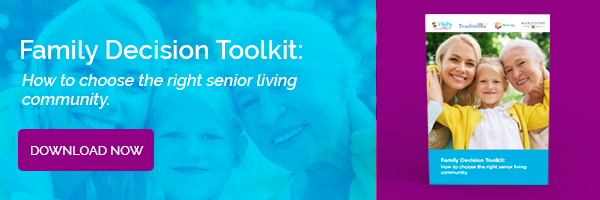Where you live after retirement can greatly impact your health and happiness. Experts say this is the result of a variety of factors ranging from opportunities for socializing to consuming a healthy diet. If you are a senior wondering if it’s time to move to an independent living or assisted living community, we have a quick checklist that might help you arrive at an answer.
7 Signs You Might Benefit From a Senior Living Community
- Challenges of home maintenance: Keeping a home in good repair is a lot of work at any age. From routine maintenance to major repairs like a new furnace or roof, these tasks can be daunting. Added to that are household chores, such as cleaning the carpet and washing the drapes. Take an objective look around your home to see how well you are managing. It might help to make a list of repairs that need to be done. Also, consider how safe you feel completing certain tasks, such as cleaning the gutters and shoveling the snow. From housekeeping to maintenance, independent and assisted living communities handle all of these details for you.
- Unintended weight gain or loss: Healthy cooking for one or two often becomes less appealing as you grow older. What may have been an enjoyable activity when you were younger, now feels like drudgery. Some seniors begin relying on convenience foods instead of home-cooked meals. Others may skip meals. The result can be unintentional weight gain or weight loss. Both of these have negative health consequences, such as developing type 2 diabetes type II or osteoporosis. Assisted living communities include well-balanced meals in the monthly fee. Independent living communities include meals in monthly fees or as an add-on service.
- Change in disposition: When you are struggling to keep up with things that used to be second nature, it can lead to a change in disposition. For example, if you are having difficulty unloading groceries from the car and getting them inside, it may leave you feeling short-tempered. Moving to a senior living community will free you from burdens like these.
- Being a victim of fraud: Falling victim to a scam is often a warning sign that an older adult might need to make a move. From roofing scams to dressing as a home utility worker to gain access to the home, criminals view seniors as an easy target. Living in a senior community can protect you from many of these types of scams.
- Feeling lonely and isolated: While most people know that mental health can suffer when a senior is lonely, research shows there is much more to it. Isolation is now considered to be a health risk for older adults. It contributes to a variety of medical conditions, including heart disease, obesity, diabetes, and even early mortality. By moving to an independent or assisted living community, you have daily opportunities to socialize with peers.
- Change in appearance: An older adult may be struggling to keep up with personal care. When you spend most of your time at home alone, showering and personal grooming might seem like too much work. It may also be fear that keeps an older person from showering. Many homes have bathrooms that aren’t senior friendly. Falls getting into and out of the bathtub are a legitimate concern for older adults. By contrast, senior living communities are designed with safety in mind including barrier-free showers.
- Problems with balance: As we grow older, it is common to experience problems with balance. Sometimes these challenges are short-term, such as a side effect of a medication. Other times the condition is linked to a chronic health condition. If you are a little unsteady on your feet, an older home might not be the most supportive environment. An environment that is supportive, however, is an independent or assisted living community. From hand rails to grab bars, senior communities are designed to make life safer for unsteady seniors.
Tour Vitality Senior Living
If more than a few of the scenarios outlined above sound familiar, it may be time to consider touring a senior living community. We invite you to consider a Vitality Senior Living community when you do. Contact us today to schedule a time!
For more information on our senior living communities, contact us or schedule a tour of a community near you today!




